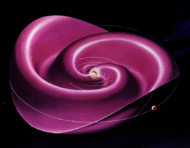
Back الفيزياء الشمسية Arabic Heliofísica Catalan Heliophysik German Heliofísica Spanish Heliofüüsika Estonian هلیوفیزیک Persian Héliophysique French Heliofisika ID ჰელიოფიზიკა Georgian Гелиофизика Kazakh

| Part of a series of articles about |
| Heliophysics |
|---|
 |
Heliophysics (from the prefix "helio", from Attic Greek hḗlios, meaning Sun, and the noun "physics": the science of matter and energy and their interactions) is the physics of the Sun and its connection with the Solar System.[1] NASA defines[2] heliophysics as "(1) the comprehensive new term for the science of the Sun - Solar System Connection, (2) the exploration, discovery, and understanding of Earth's space environment, and (3) the system science that unites all of the linked phenomena in the region of the cosmos influenced by a star like our Sun."
Heliophysics is broader than Solar physics, that studies the Sun itself, including its interior, atmosphere, and magnetic fields. It concentrates on the Sun's effects on Earth and other bodies within the Solar System, as well as the changing conditions in space. It is primarily concerned with the magnetosphere, ionosphere, thermosphere, mesosphere, and upper atmosphere of the Earth and other planets. Heliophysics combines the science of the Sun, corona, heliosphere and geospace, and encompasses a wide variety of astronomical phenomena, including "cosmic rays and particle acceleration, space weather and radiation, dust and magnetic reconnection, nuclear energy generation and internal solar dynamics, solar activity and stellar magnetic fields, aeronomy and space plasmas, magnetic fields and global change", and the interactions of the Solar System with the Milky Way Galaxy.
- ^ Gough, D.O. (1983). "Our first inferences from helioseismology". Physics Bulletin. 34 (12): 502–507. Bibcode:1983PhB....34..502G. doi:10.1088/0031-9112/34/12/019.
- ^ ``Heliophysics. The New Science of the Sun - Solar System Connection: Recommended Roadmap for Science and Technology 2005 - 2035.; https://ntrs.nasa.gov/search.jsp?R=20090010233
© MMXXIII Rich X Search. We shall prevail. All rights reserved. Rich X Search